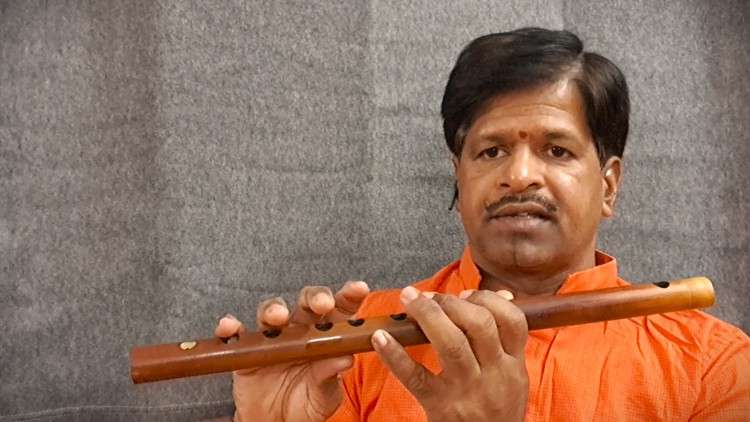
Learn a popular Krithi BANTUREETHI KOLUVU in raaga HAMSANADAM of ADI THALAM
What you will learn
Students can practice and play along while watching the fingering and notations simultaneously
Students get to know the actual method of playing Krithis.
Students can learn the Half Notes on Flute.
Students can easily pick up the fingering skills by learning line by line of the Krithis.
Why take this course?
Tyagaraja, born as Muthuswami Dikshitar on 4 or 5 March 1785 (Chaitra Bahula Panchami in the Telugu calendar), was a pioneering figure in Carnatic music. He is considered one of the Trinity of Carnatic music, along with Shyama Shastry and Muthuswami Dikshitar (not to be confused with himself). His contribution to music is immense, and his compositions continue to influence musicians even today.
Here are some key points about Tyagaraja’s life and contributions:
- Early Life: Tyagaraja was born into a Brahmin family in a village called Tillyadi (now Tilla, Guntur district) in the Madras Presidency of British India. He was named Rajacharya at birth and later became known as Venkataramanaraju or Venkataramana Swami.
- Musical Genius: His musical talent emerged early in his life. He was proficient in singing, composing, and playing the violin by his teens. He had a deep understanding of theoretical aspects of music such as svara (notes), raga (melodic modes), and tala (rhythmic cycles).
- Philosophical Outlook: Tyagaraja’s compositions often reflect his devotion to Rama, whom he considered the ultimate reality. His songs convey philosophical and spiritual messages and are imbued with bhakti or devotion.
- Musical Innovations: He introduced new concepts in Carnatic music, such as the jati (melakarta) system of ragas, which became a foundation for classical music in the region. His approach to music was more focused on expression rather than adhering strictly to the technicalities of classical music.
- Compositions: Tyagaraja’s repertoire includes a variety of musical forms like kritis, gitas, varnas, jatis, raga-tanam-pallavis, and tillanas. His compositions are notated in a simple way to enable easy learning and singing by others.
- Influence on Carnatic Music: Tyagaraja’s compositions have shaped the language of Carnatic music, influencing its style and structure. His approach to ragas and his emphasis on melodic improvisation within the raga framework have been instrumental in the evolution of Carnatic music.
- Palm Leaf Notations: Tyagaraja’s compositions were initially noted down on palm leaves by his disciples. However, due to various reasons, a significant portion of his musical legacy was lost. The surviving compositions are treasured and continue to be taught and performed across India.
- Legacy: Tyagaraja passed away on 6 or 7 April 1847 (Vaisakha Bahula Dvadashi in the Telugu calendar). In his honor, the Tyagaraja Aradhana music festival is held every year, attracting musicians and enthusiasts from around the globe.
- Tyagaraja Ustav: This is a week-long celebration that takes place at Thiruvaiyaru, his samadhi shrine. It features concerts by leading Carnatic vocalists, violinists, flutists, and other musicians. The festival culminates in a massive community singing of the Pancharatna kritis, a set of five devotional songs composed by Tyagaraja.
Tyagaraja’s contributions to Carnatic music have been recognized and celebrated for their profound impact on the art form. His compositions are a testament to his genius and continue to inspire musicians to explore the depths of ragas and the nuances of melodic expression.